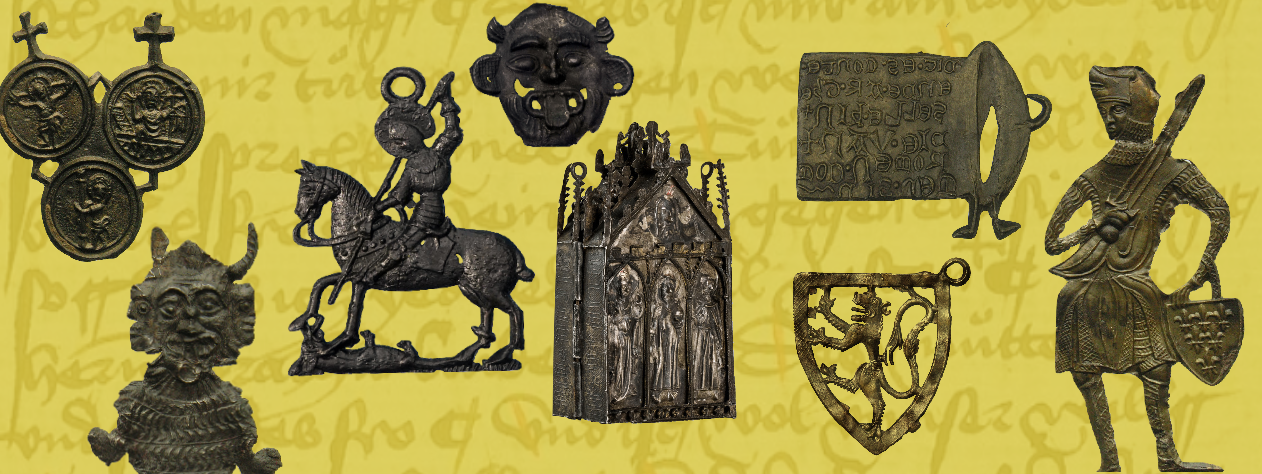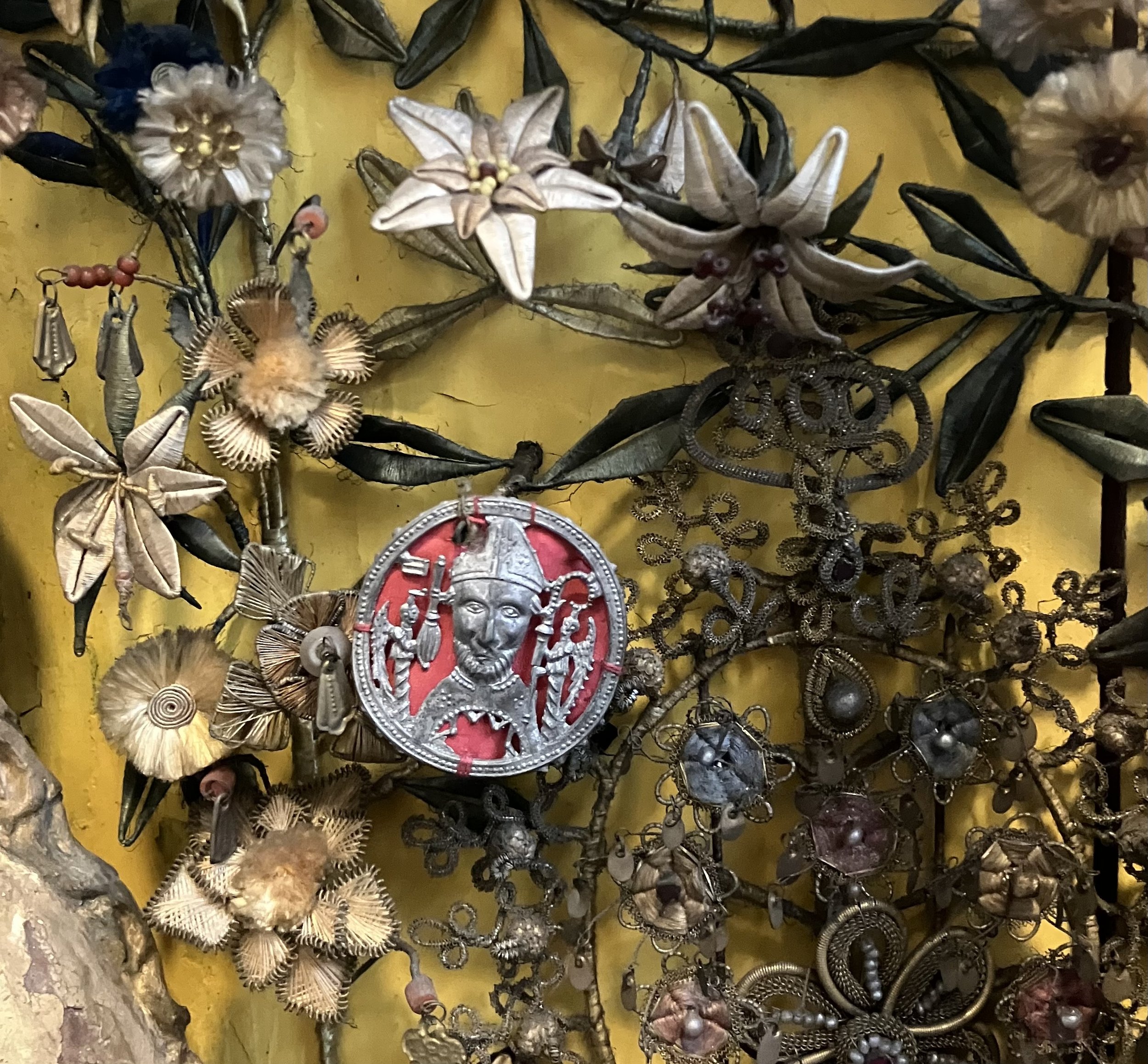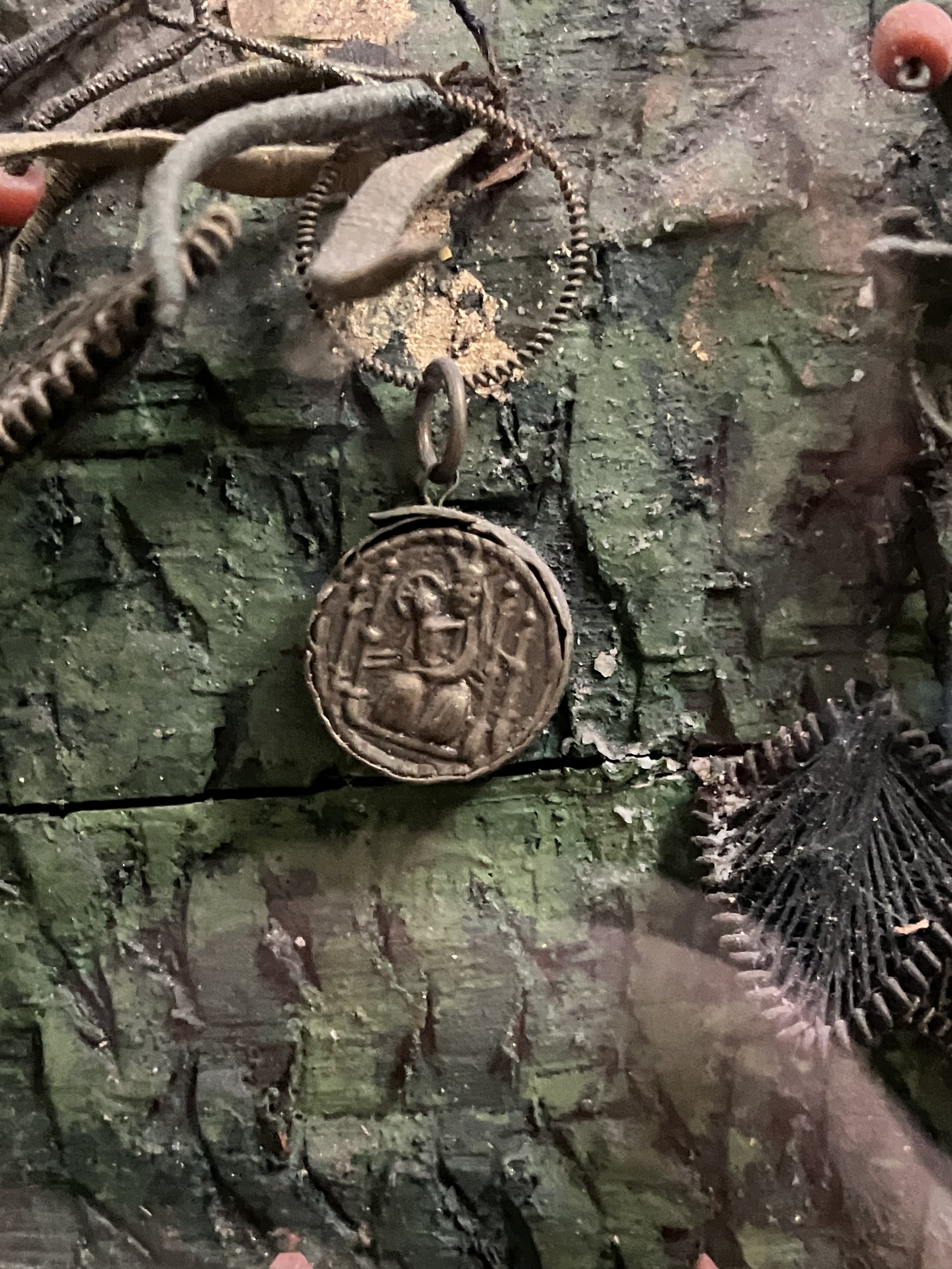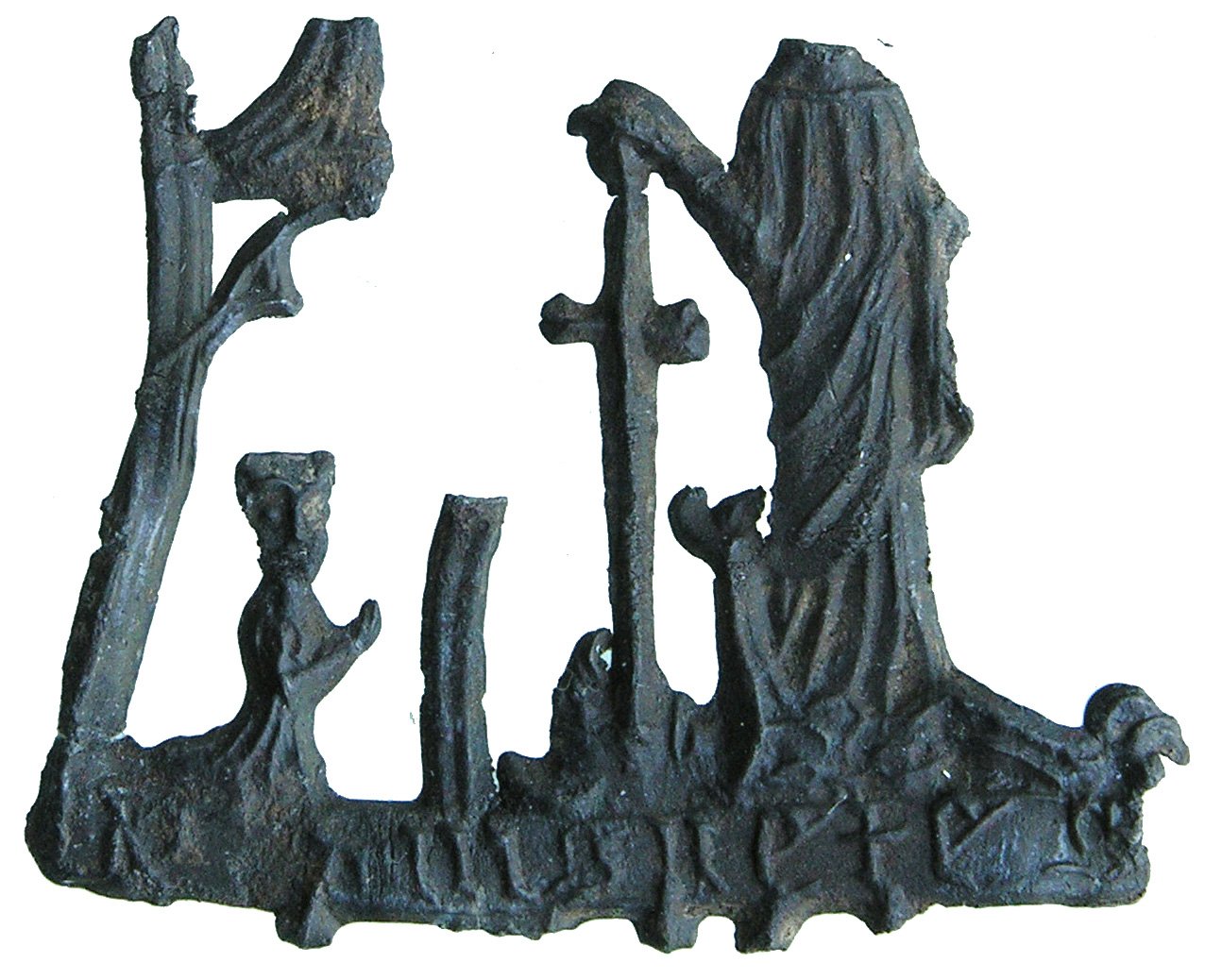looking closely at an enclosed garden (Besloten Hofje) at Sint-Dimpnakerk, Geel
When I visited Sint-Dimpnakerk (The Church of Saint Dymphna) in Geel, Belgium at the end of May to learn more about the church and the history surrounding Saint Dymphna, I did not anticipate finding six pilgrim badges in a sixteenth-century enclosed garden (Besloten Hofje) in a corner of the church. Though these were not Saint Dymphna pilgrim badges, my attention quickly turned towards them as I tried to discern what they were and where they had come from.
Enclosed gardens are a type of reliquary altarpiece found in houses of religious women in the late fifteenth and sixteenth centuries in the Low Countries. [1] The enclosed garden in Sint-Dimpnakerk was made in the first quarter of the sixteenth century in Mechelen, Belgium. Enclosed gardens have certain shared characteristics: “Small wooden boxes frame not only relics but also wax seals, jewellery, poupées de Malines [polychrome statuette], glass beads and pilgrim badges against a textile background of silk vegetation.”[2] The name ‘enclosed garden’ and the garden iconography central to them refer back to the hortus conclusus of the Song of Solomon (see verse 4:12). The Sint-Dimpnakerk enclosed garden evokes for the maker and viewer a fusion between Christ the bridegroom (displayed here in his Passion) and the church as his bride.
Sint-Dimpnakerk enclosed garden (Besloten Hofje), Geel, Belgium. Partly from the first quarter of the 16th century, Mechelen, Belgium, circa. . Partly restored and supplemented ca. 1863 by E.H. Theodoor Kuyl. Photograph: Hannah Gardiner.
The Sint-Dimpnakerk enclosed garden has been largely overlooked by scholarship, which explains why most of its badges haven’t yet been documented. It is outshined at Sint-Dimpnakerk by the impressive early sixteenth-century oak altarpiece depicting the story of Dymphna. It is also outshined by the seven famous, enclosed gardens of Mechelen, which have been preserved and restored and are now displayed at the Museum Hof van Busleyden (Mechelen).
The colours of the Sint-Dimpnakerk enclosed garden are faded from light, though its components remain well intact. Six saints stand beneath a crucified Christ amid bright flowers, fabric relics, and pilgrim badges. The badges are camouflaged in the garden scene and difficult to see even from the vantage point of the altar. I returned to the church at different hours of daylight to look into the enclosed garden and found a new badge each time. Some badges are carefully sewn into the flowers surrounding them. Others are placed nearby other relics and appear as a sort of backdrop for the saints. Here badges live a second life different from their first one as pilgrim souvenirs.
Where did these pilgrim badges come from? How long had these badges been kept and why? How did religious women making these enclosed gardens come across them? How did the restoration and supplementation by E.H. Theodoor Kuyl in 1863 affect the badges? I knew I could find an answer to the first question, perhaps the only answerable one. I first consulted the Kunera database to see whether the badges, or ones similar to them, had been documented. I contacted Dr. Hanneke Van Asperen at Radboud University for help identifying the badges’ origins. The captions accompanying the gallery of six photographs below contain her initial answers.
Pewter badge, reliquary head of Servatius as bishop with beard flanked by angels, one holding key, bit turned upwards, and the other holding a crosier in round frame, attachment unknown, Maastricht, the Netherlands 1500-1524 (according to Koldeweij), found location unknown, measurements unknown (Kunera 05981). Besloten Hofje, Sint-Dimpnakerk, Geel.
Metal badge, enthroned Mary with Child sitting on her left side in round badge. Besloten Hofje, Sint-Dimpnakerk, Geel.
Hanneke Van Asperen pointed to two similarly enthroned Mary badges with the inscription, ‘DE HAL’, from Halle (Belgium) about forty kilometres south-west of Mechelen. See Kunera 15229 and 13792. No identical badge could be found on the database.
Pewter badge, dotted hexagonal frame decorated with rows of pearls and with dot-in-circles along the corners. Besloten Hofje, Sint-Dimpnakerk, Geel.
Hanneke Van Asperen pointed out that if you look closely, there appears to be a “vague image of a tunic (in unidentified material: paper? parchment?),” indicating this is a badge from Aachen, Germany. For some other badges where tunic is the central image, see Kunera 03496, 25814, 05061. For a badge with a similar shape, see Kunera 25312v. No identical badge could be found on the database.
Metal badge, Madonna and Child on oval aureole pendant. Besloten Hofje, Sint-Dimpnakerk, Geel.
There are several badges in the Kunera database with very similar imagery: see Kunera 00433r and 00433v; 00434r and 00434v; 04386r and 04386v; 04686r and 04686v. Verso of all these badges depict a tunic of the Virgin Mary, indicating provenance in Aachen, Germany. No identical badge could be found on the database.
Stamped round badge, Madonna and Child. Besloten Hofje, Sint-Dimpnakerk, Geel.
Dr. Van Asperen points to Kunera 16748 as an identical badge. Further information about these badges is unknown.
Round badge, possible depiction of the Virgin enthroned or what I think may be an Anna Selbdritt (Saint Anne with Virgin Mary and Christ Child), Düren(?). Besloten Hofje, Sint-Dimpnakerk, Geel.
Further information about this badge is unknown.
Though pilgrim badges are commonly found in enclosed gardens, discovering these new badges at Sint-Dimpnakerk was a very welcomed surprise on the research trip. There remains much fruitful study to be undertaken about the role of badges in this enclosed garden and the afterlife they live there and elsewhere — something I will be reflecting on in an upcoming blog post.
Works Cited
[1] “Enclosed Gardens of Mechelen (kikirpa.be).” Royal Institute for Cultural Heritage, KIK-IRPA.
[2] “Enclosed Gardens (kikirpa.be).” Royal Institute for Cultural Heritage, KIK-IRPA.
[3] Personal communication with Dr. Hanneke Van Asperen.
Sculpture group of the Martyrdom of Saint Dymphna. Dymphna, sandstone, Master Merten, early 16th century, 86 x 67 x 37 cm. King, wood, Thomas Hazaert, Mechelen (BE), 1609-1610, 124 x 44 x 30 cm. Gasthuismuseum Geel, Collection Gasthuiszusters Augustinessen Geel, inv. 03899.
I am very grateful to Maria Gerits and Frie Van Ravensteyn for the time and knowledge they shared with me during my stay in Geel. Another thanks is owed to Jolien Hoekx and Julie Cooymans at the Gasthuismuseum for their help before I arrived.
Written by Hannah Gardiner. Edited by Dr. Ann Marie Rasmussen. All photographs by Hannah Gardiner.













